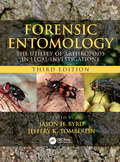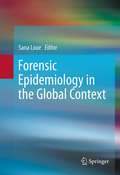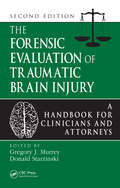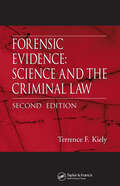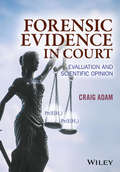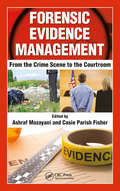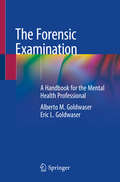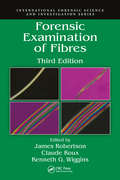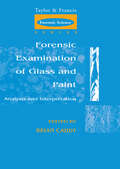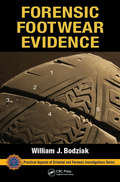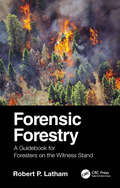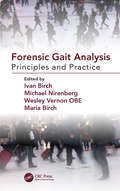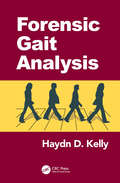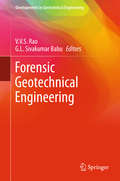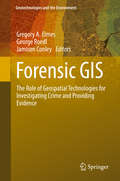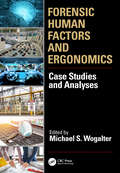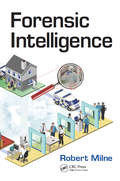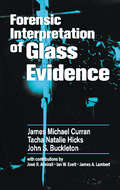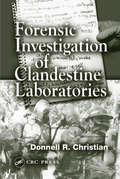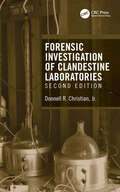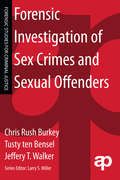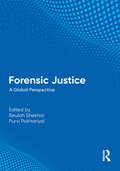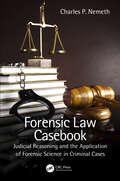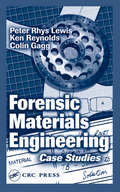- Table View
- List View
Forensic Entomology: The Utility of Arthropods in Legal Investigations, Third Edition
by Jason H. Byrd; Jeffery K. TomberlinForensic Entomology: The Utility of Arthropods in Legal Investigations, Third Edition continues in the tradition of the two best-selling prior editions and maintains its status as the single-most comprehensive book on Forensic Entomology currently available. It includes current, in-the-field best practices contributed by top professionals in the field who have advanced it through research and fieldwork over the last several decades. The use of entomology in crime scene and forensic investigations has never been more prevalent or useful given the work that can be done with entomological evidence. The book recounts briefly the many documented historical applications of forensic entomology over several thousand years. Chapters examine the biological foundations of insect biology and scientific underpinnings of forensic entomology, the principles that govern utilizing insects in legal and criminal investigations. The field today is diverse, both in topics studied, researched and practiced, as is the field of professionals that has expanded throughout the world to become a vital forensic sub-discipline. Forensic Entomology, Third Edition celebrates this diversity by including several new chapters by premier experts in the field that covers such emerging topics as wildlife forensic entomology, microbiomes, urban forensic entomology, and larval insect identification, many of which are covered in depth for the first time. The book will be an invaluable reference for investigators, legal professionals, researchers, practicing and aspiring forensic entomologists, and for the many students enrolled in forensic science and entomology university programs.
Forensic Epidemiology in the Global Context
by Sana LoueAs globalization causes profound changes in business, industry, and trade,it can also have significant effects on populations, environments, and individuals.These effects may be harmful, resulting in injury or illness, prompting the critical question: How best to correct wrongs caused to individuals, communities, and/or the environment of one country by the actions of individuals or corporations of another? Possible answers lie in an emerging discipline. Forensic Epidemiology in the Global Context opens meaningful windows onto the processes of forensic epidemiology, the roles of the epidemiologist in civil disputes, and the potential contribution of the field to legal and justice efforts worldwide. Case examples from the U.K., Nigeria, Ecuador, Romania, and Australia illustrate commonly used methodologies and the challenges involved in their use in U.S. and international courts of law. A chapter on expert testimony takes readers through qualification and admissibility issues, report requirements, and working with attorneys. Included in the coverage: Forensic epidemiology in the international legal arena.The epidemiologist as an expert in litigation.Epidemiological evidence in tort law: dispatches from the U.K.Liability for occupational exposure: the role of epidemiology.Forensic epidemiology and environmental justice.Forensic epidemiology, pathology, ethnics, and human rights.By emphasizing both the scientific and legal components of the equation, Forensic Epidemiology in the Global Context gives researchers and graduate students in epidemiology a unique and timely guide to the present and future of an increasingly salient field.
The Forensic Evaluation of Traumatic Brain Injury: A Handbook for Clinicians and Attorneys, Second Edition
by Gregory J. Murrey Donald StarzinskiDrawing on the expertise of several well-known figures in the medical, neuropsychological, and legal professions, Forensic Evaluation of Traumatic Brain Injury: A Handbook for Clinicians and Attorneys, Second Edition provides a concise, general overview of the forensic assessment process and the issues surrounding Traumatic Brain Injury (TBI). The
Forensic Evidence: Science and the Criminal Law, Second Edition
by Terrence F. KielyFocusing on issues raised at Interpol‘s 14th Forensic Science Symposium, this volume offers a complete overview and analysis of the scientific and legal aspects of each of the forensic disciplines. It updates cases and discusses recent applications of Frye/Daubert, the admissibility of eyewitness identification, the explosion of cases and statutes addressing post-conviction DNA, the rise in attention to cold cases, and other challenges. This is the book that those in the forensic sciences need to have on hand to successfully prepare for what may await them in the courtroom.
Forensic Evidence in Court: Evaluation and Scientific Opinion
by Craig D. AdamThe interpretation and evaluation of scientific evidence and its presentation in a court of law is central both to the role of the forensic scientist as an expert witness and to the interests of justice. This book aims to provide a thorough and detailed discussion of the principles and practice of evidence interpretation and evaluation by using real cases by way of illustration. The presentation is appropriate for students of forensic science or related disciplines at advanced undergraduate and master's level or for practitioners engaged in continuing professional development activity.The book is structured in three sections. The first sets the scene by describing and debating the issues around the admissibility and reliability of scientific evidence presented to the court. In the second section, the principles underpinning interpretation and evaluation are explained, including discussion of those formal statistical methods founded on Bayesian inference. The following chapters present perspectives on the evaluation and presentation of evidence in the context of a single type or class of scientific evidence, from DNA to the analysis of documents. For each, the science underpinning the analysis and interpretation of the forensic materials is explained, followed by the presentation of cases which illustrate the variety of approaches that have been taken in providing expert scientific opinion.
Forensic Evidence Management: From the Crime Scene to the Courtroom
by Ashraf Mozayani Casie Parish-Fisher"Evidence management has become a crucial component for the law enforcement community. I truly believe this book is essential in assisting criminal investigators and a valuable resource for managing evidence."—Jeremiah Sullivan, Chairman, Board of Directors, Texas Division of the International Association for Identification; Senior Crime Scene Specialist (Retired). Austin Police Department As technology and technical applications continue to advance in the forensic sciences, the undertakings at crime scenes have become even more critical. Crime scene investigators must ensure that evidence is properly collected, document, packaged, and stored in a manner that maximizes the ability of laboratories to derive meaning and results from the evidence provided them. Forensic Evidence Management: From the Crime Scene to the Courtroom provides best practices policies for forensic science entities and their employees to maintain chain of custody and evidence integrity throughout the course of evidence collection, storage, preservation, and processing. The focus of the book will be to address the issues related with evidence handling and analysis inside the forensic laboratory, in particular, and to offer best practices and guidelines from leading forensic experts in the field. Forms of evidence covered include biological, chemical, trace, firearm, toolmark, fingerprint, and a host of others types recovered at crime scenes. The book concludes with a chapter on ethics, bias, and ethical practices in evidence handling in the field and laboratory analysis. Test Bank and PowerPointTM slides are available for download from the Taylor & Francis ancillary Web site for qualifying course adopters.
The Forensic Examination: A Handbook for the Mental Health Professional
by Alberto M. Goldwaser Eric L. GoldwaserThis book prepares the mental health professional to use scientific skills when working within a legal framework. Written by a seasoned forensic psychiatrist with decades of experience and professional honors, this text answers some of the most challenging questions psychiatrists face when mental health intersects with the courtroom. The text is supported with 34 case vignettes that demonstrate ways in which seemingly simple diagnoses have unique layers of complexities that are vital within the legal system. The resource covers topics that may not be elucidated in medical schools, including what to expect from an expert witness, how to communicate with attorneys who lack a medical background, managing opposing viewpoints, psychiatric and medical malpractice, harassment, employment status, and other difficult topics as it pertains to the law. The text also knits this understanding of forensic psychiatry with clinical knowledge, addressing violence and risk assessment, discrimination, disability evaluation, psychiatric disorders, criminal and civil competence, end-of-life care and decisions, and a wide array of medical topics that have unique concerns when placed in the context of the legal system.The Forensic Examination is a vital resource for psychiatrists, psychologists, criminal and civil defenders, and all professionals working with persons in the medicolegal system.
Forensic Examination of Fibres (International Forensic Science and Investigation)
by James Robertson Claude Roux Kenneth G. WigginsIn order for forensic fibre examiners to fully utilize fibre and textile evidence during their analysis, they require not only specialised forensic knowledge but also in-depth knowledge of fibres, yarns and fabrics themselves. Production, both the chemical and physical structure, and the properties of these materials is required in order to determine the value of fibre evidence. This includes knowing production figures, fashion changes, sudden arrivals of new materials, dye variability, and numerous other factors that may have a bearing on the information obtained. Fully updated with the latest advances, Forensic Examination of Fibres, Third Edition continues in the tradition of the First (1992) and Second Editions (1999) as the premier text on the subject of forensic fibre analysis. The international team of contributing authors detail the recovery of the evidence—through the different stages of laboratory examination—to the evaluation of the meaning of findings. The coverage has been considerably expanded, and all material, has been revised and wholly updated. Topics covered include examining damaged textiles, infrared microspectroscopy and thin layer chomatography, and colour analyses. This edition also highlights the critical role of quality assurance in ensuring the reliability of the technical observations and results, and, in doing so, looks at the implications of supervisory managers and labs in the accurate and responsible analysis of such evidence. Features include: Outlining evidentiary process from collecting and preserving the evidence at the crime scene through the laboratory analysis of fibres Detailing the latest developments and emerging technologies including Kevlar and other such advances in fibre technology Coverage of a broad array of fibres both, natural (cellulose, protein, and mineral) and man-made fibres including synthetic, inorganic and regenerated Forensic Examination of Fibres, Third Edition is a much-needed update to the classic book, serving as an indispensable reference to crime scene technicians, laboratory forensic scientists and microscopists, students in police, forensic, and justice science programs.
Forensic Examination of Glass and Paint: Analysis and Interpretation
by Brian CaddyThis volume represents an approach to the analysis of glass and paint as they occur as trace evidence in forensic cases. Each chapter is written by an expert in their particular area. The book is divided into two sections: one referring to paint and one referring to glass. Each section covers an introduction to the composition of these materials an
Forensic Facial Reconstruction
by Caroline WilkinsonThis book's major contributions include a detailed description of the Manchester method of facial reconstruction, using all the available published data on tissue depths and variation with age, sex, stature and ethnic origin. Caroline Wilkinson also includes an evaluation of the methods and problems associated with reconstructing the faces of children. Forensic facial reconstruction reproduces an individual's face from skeletal remains. Used when identification is otherwise impossible, it can give a name to the dead in forensic cases, or in archaeological contexts, provide a tangible impression of real individuals from our past.
Forensic Footwear Evidence: Detection, Recovery and Examination, SECOND EDITION (Practical Aspects of Criminal and Forensic Investigations)
by William J. BodziakThe utilization of footwear impression evidence continues to evolve with new materials, equipment and techniques, providing an increased ability to detect, record, enhance, and examine this form of evidence. Recently developed technology now allows investigators to more efficiently or, in some cases, instantly link multiple crime scenes where impressions have been produced by the same perpetrator. Forensic Footwear Evidence covers a wide range of relevant topics, including historical references, general information about the formation and investigative use of footwear impressions, and the best practices and considerations that apply to the recovery, enhancement, and examination of this evidence. Drawing on the author’s 44 years of acquired knowledge and experience, it is the most comprehensive and authoritative text published to date on this topic. Highlighted topics covered within the book include Three chapters covering footwear manufacturing Shoe grading, sizing, and the forensic application of sizing information Examination and reporting procedures Casting impressions in snow Barefoot evidence Topics of interest for both prosecution and defense attorneys The book includes more than 300 color photographs and illustrations throughout, as well as case examples that apply theoretical concepts to the real world. A single, complete reference on the subject, Forensic Footwear Evidence presents a wide range wealth of information that will serve as an invaluable reference to novice and experienced examiners, crime scene technicians, investigators, and prosecution and defense counselors alike.
Forensic Forestry: A Guidebook for Foresters on the Witness Stand
by Robert P. LathamForensic Forestry: A Guidebook for Foresters on the Witness Stand is a one-of-a-kind, hands-on resource for those forestry and land use professionals called upon to work on legal cases and testify in court. Land use and forestry issues in the United States, in particular—and likewise around the world—have become increasingly contentious, scrutinized, and debated. There is little to suggest that conflicts over forestlands will cease in the near future, in fact, quite the opposite. There are already a number of informative books available on land use and forestry, and related issues under the broader heading of environmental science. As such, while this book will not go into these concepts in detail, if someone is already an expert in land use and forestry, this book will tell them the ins and outs of the legal system and how they can best serve to make a case, using evidence, in a court of law. Coverage addresses the necessary background, and legwork involved, in providing technical expertise for such cases to be adjudicated. Since professionals’ expertise is often focused on ecological issues, chapters look at the economic factors and how money, policy, and corporate interests come into play—the crux of where the professional forester’s ability to present evidence and expertise becomes critical. The author provides an overall understanding of the courts, and the legal process. Coverage includes recommendations to professionals working on cases—and in the courtroom—in how to present evidence and testify in cases over land use and forestland rights, forestry management and safety, criminal and civil cases in liability in forest fires—among myriad others. Key Features: A book by a professional for professionals in the field of forestry and those called to testify in cases of forest and wildfires, eminent domain, land disputes, tort, and liability cases Written in easy-to-read, non-technical jargon to provide tools to best serve as an expert witness and consultant to support attorneys in civil and criminal cases Details unique, real-world cases study examples, detailing how they were adjudicated based on evidence and testimony provided Presents a legal background into the court system, courtroom procedure, the types of legal cases as they relate to forensic forestry As such, Forensic Forestry is a welcome addition to those professionals called upon to consult on, and testify in, such cases including land use professionals, foresters and forestry managers, ecologists, environmentalists, environmental policy advocates, and those in related fields.
Forensic Gait Analysis: Principles and Practice
by Ivan Birch Michael Nirenberg Wesley VernonGait analysis is the systematic study of human walking, using the eye and brain of experienced observers, augmented by instrumentation for measuring body movements, body mechanics, and the activity of the muscles. Since Aristotle’s work on gait analysis more than 2000 years ago, it has become an established clinical science used extensively in the healthcare and rehabilitation fields for diagnosis and treatment. Forensic Gait Analysis details the more recent, and rapidly developing, uses of gait analysis in the forensic sciences. This includes using observational gait analysis, especially based on video recordings, to assist in the process of identifying individuals. With the increase in use of CCTV and surveillance systems over the last 20 to 30 years, there has been a steady and rapid increase in the use of gait as evidence. Currently, gait analysis is widely used in the UK in criminal investigations, with increasing awareness of its potential use in the US, Europe, and globally. The book details the history of the science, current practices, and emergent application to establish best-practice standards that conform to those of other forensic science disciplines. Engagement with the Forensic Science Regulator, the Chartered Society of Forensic Sciences in the UK, and the International Association for Identification has helped to ensure and enhance the quality assurance of forensic gait analysis. However, there remains a fundamental lack of standardized training and methodology for use in an evidentiary and investigative capacity. This book fills that void, serving as one of the first books to reflect the state of current practice and capabilities—outlining a standard of practice and expectations as to what gait analysis, and by association gait analysis experts, and corroborate. Forensic Gait Analysis will reflect the research and current forensic practices and serve as a state-of-the-art, definitive guide to the use of gait analysis in the forensic context—for both education and training purposes. It will be a welcome addition to the library of professionals in the areas of podiatry, gait analysis, forensic video analysis, law enforcement, and legal practitioners.
Forensic Gait Analysis
by Haydn D. KellyForensic Gait Analysis examines the inter-section of podiatric medicine with forensic investigation—that which links or dissociates a suspect to a crime through analysis of their gait, that is their movement—how an individual walks, runs, and bends. This book provides a concise explanation of how an individual's gait and biomechanics are forensically analysed and compared, using video imagery in the process of human identification and investigations. Along with the presentation and delivery of material with case law references illustrating the use of expert evidence. Gait analysis is a long-standing component of the diagnostic and therapeutic tool set of medical disciplines, although the knowledge goes back much further. The area has also captured the interest of technology engineers and others, as the development and use of forensic gait analysis as an investigative and evidential device continues to widen. Features: • Presents succinct knowledge on forensic gait analysis. • 100+ illustrations with photographs and diagrams; over 850 references. • Considers the technical and scientific basis of the field including, the history of gait, musculoskeletal, neurology, emotions and gait, forensic statistics, photogrammetry, and recognises the trajectory of development into IT and software solutions. • Coverage on CCTV imagery and other video footage for use in the process of identification and investigations. • Details are provided on report writing and giving expert evidence in the legal systems. • Contributors across all subject areas. This definitive fully referenced text on Forensic Gait Analysis is a welcome publication for healthcare professionals, lawyers, counsel, investigators, forensic practitioners, and students wishing to know more on the subject and this growing domain.
Forensic Geotechnical Engineering
by V.V.S. Rao G.L. Sivakumar BabuIn this edited volume on advances in forensic geotechnical engineering, a number of technical contributions by experts and professionals in this area are included. The work is the outcome of deliberations at various conferences in the area conducted by Prof. G. L. Sivakumar Babu and Dr. V. V. S. Rao as secretary and Chairman of Technical Committee on Forensic Geotechnical Engineering of International Society for Soil Mechanics and Foundation Engineering (ISSMGE). This volume contains papers on topics such as guidelines, evidence/data collection, distress characterization, use of diagnostic tests (laboratory and field tests), back analysis, failure hypothesis formulation, role of instrumentation and sensor-based technologies, risk analysis, technical shortcomings. This volume will prove useful to researchers and practitioners alike.
Forensic GIS
by Gregory A. Elmes George Roedl Jamison ConleyA variety of disciplines and professions have embraced geospatial technologies for collecting, storing, manipulating, analyzing and displaying spatial data to investigate crime, prosecute and convict offenders, exonerate suspects and submit evidence in civil lawsuits. The applications, acceptability and relevance and procedural legality of each geospatial technologies vary. The purpose of this book is to explain the nature of geospatial technologies, demonstrate a variety of geospatial applications used to investigate and litigate civil and criminal activities and to provide a reference of current acceptability of geospatial technology in the production of evidence. This book is an introductory overview designed to appeal to researchers and practitioners across disciplinary boundaries. The authors of this book are researchers and practitioners across disciplines and professions, experts in the field.
Forensic Human Factors and Ergonomics: Case Studies and Analyses (Human Factors and Ergonomics)
by Michael S. WogalterThis book has 18 case study chapters investigating various injury scenarios through the use of a Human Factors and Ergonomics (HFE) analysis. Each injury scenario derives from one or more similar lawsuits (but names, places and some of the details are fictionalized). The scenarios describe a ‘slice of life’ of people interacting with products, equipment, tasks, and environments before they are seriously hurt. The forensic analysis that follows each scenario gives a background of prior similar events and systematically examines potential causes leading to the injury event. There is emphasis on the person-machine interface, human error, hazard analysis, hazard control and a model of communication-human information processing (C-HIP). Chapters are authored by highly experienced expert witnesses in HFE. The methods used are general techniques that can be applied to other injury scenarios, but would be better if employed earlier in a product’s life cycle to prevent or limit injury. The first three chapters introduce concepts useful for the analyses in the case study chapters. The last chapter offers some broad take-away points that cut across several of the case studies. Features contributions by persons who have extensive experience in HFE and who have served professionally in the role of an expert witness in various legal cases mostly in product liability Gives a broad range of situations to illustrate where HFE considerations could improve product or environmental safety. There is an emphasis on children/caregivers, and adult activities such as driving Uses mitigation strategies to reduce the likelihood of occurrence and severity of adverse events Includes a first-person scenario at the beginning of each chapter Allows the lessons learned to be adaptable to other domains where people interact with products and environments
Forensic Intelligence
by Robert MilneWhen forensic recoveries are properly processed and recorded, they are a major intelligence source for crime investigators and analysts. The majority of publications about forensic science cover best practices and basic advice about evidence recovery and storage. Forensic Intelligence takes the subject of forensics one step further and describes how to use the evidence recovered at crime scenes for extended analysis and the dissemination of new forensic intelligence. The book draws on the author’s 40 years of experience as a crime scene examiner, latent print examiner, and the Head of Forensic Intelligence, New Scotland Yard, in the London Metropolitan Police Intelligence Bureau (MIB). It supplies practical advice on how to use all forensic recoveries in a modern, analysis-driven, intelligence-led policing environment. The text covers evidentiary procedures related to each of the main crime types, as well as the production of intelligence products from police data.Accompanying the book are downloadable resources with a plethora of additional resources, including Treadmark Express footwear evidence software; exemplar templates for the input of forensics, behaviours, and method data into intelligence systems; and other material.This reliable resource is designed for police services of all sizes and capabilities—from the largest organizations with thousands of employees and big budgets down to the smallest department with a few officers. By mastering the basic crime recording and intelligence processes in this volume, investigators can make the best use of all their forensic recoveries. CD ROM Contents:Treadmark Express Footwear Evidence Software and User’s ManualOperation Bigfoot Footwear Pattern Distribution Graphs (London 2005)Example CSI Forensic Intelligence TemplateShoe and tool Marks Coding DocumentReport on the Vision of Forensic Intelligence and Strategic ThinkingA Unified Format Spreadsheet for Merging Drug Legacy Data from Different Forensic Science LaboratoriesForensic Intelligence Report (FIR) TemplateRole Description Example–Forensic Intelligence ManagerFootwear Intelligence Process MapBallistics Intelligence Process Map–Inputs & Outputs
Forensic Interpretation of Glass Evidence
by James Michael Curran Tacha Natalie Hicks John S. BuckletonIntended for forensic scientists and students, this book provides the necessary statistical tools and methodology for introducing forensic glass evidence into the laboratory. It contains an introductory chapter on glass evidence procedures and analysis before covering topics such as classical approaches to handling glass evidence, the application of Bayesian statistics to forensic science, and the use of histograms. The authors present both the physical and chemical examinations performed on glass along with their interpretations. With free software available for downloading at the authors' web site, scientists can apply their own data and draw conclusions using the principles detailed in the text.
Forensic Investigation of Clandestine Laboratories
by Jr., Donnell ChristianClandestine lab operators are not the mad scientists whose genius keeps them pent up in the laboratory contemplating elaborate formulas and mixing exotic chemicals. In fact, their equipment is usually simple, their chemicals household products, and their education basic. Most of the time the elements at the scene are perfectly legal to sell and own
Forensic Investigation of Clandestine Laboratories
by Donnell R. Christian, Jr.Forensic Investigation of Clandestine Laboratories, Second Edition is fully updated to address all aspects of the forensic investigation of clandestine laboratories. While, the first edition focused on the domestic clandestine manufacture of contraband substances, this edition expands the scope to more fully address the clandestine manufacture of explosives that have become a threat that is global in nature. In clandestine laboratory operations, equipment is often simple, household chemical products are utilized, and the education of the operators basic. In fact, most of the time these elements individually are perfectly legal to sell and possess. However, the combination of all these elements is what becomes the scene of illicit activity and a criminal operation. In response to the increase in use of homemade explosive mixtures by terrorists, both domestically and internationally, the section clandestine manufacture of explosives is greatly enhanced. Topics are presented in a manner which, while detailed, will not compromise the tactics, techniques, or procedures utilized by law enforcement and military personnel in their ability to combat the clandestine manufacture of contraband substances and the battle against domestic and international terrorism.Key features: • Examines tell-tale signs to look for in recognizing a clandestine lab• Outlines how to safely process the site of a clandestine lab• Details how to analyze collected evidence in the examination laboratory • Provides guidelines as to what to derive from the physical evidence• Offers specific tactics to effectively present the opinions associated with evidence that has been collected during the investigation in a written report, military style briefing or to a jury in a legal proceeding.Forensic Investigation of Clandestine Laboratories, Second Edition guides the reader through the process of recognizing these illegal manufacturing operations. Then it examines the methods as to how to compile the volume of associated evidence into a package that can be presented in a court of law, or to military commanders for decisive action. It is an invaluable resource, that will prove useful to chemistry lab technicians, forensic investigators, fire and first responder professionals, military personnel, police investigative agencies and narcotics units, and lawyer trying cases involving clandestine labs.
Forensic Investigation of Sex Crimes and Sexual Offenders
by Jeffery T. Walker Chris Rush Burkey Tusty Ten BenselThe investigation of sex crimes is a specific function for many law enforcement agencies, requiring an understanding of how to investigate, process crime scenes, interact with victims and offenders, and prepare for court. Drawing on new methods of investigation and the effects of such crimes on victims, Forensic Investigation of Sex Crimes and Sexual Offenders provides in-depth coverage in these areas, offering a valuable supplement for criminal justice courses and an accessible guide for law enforcement.
Forensic Justice: A Global Perspective
by Beulah Shekhar Purvi PokhariyalForensic science is playing an increasingly important role in criminal investigations, as it provides scientific methods and techniques to gather and analyse evidence from crime scenes. Forensic evidence can be crucial in identifying suspects, linking them to the crime scene, and helping to secure convictions in court. In this sense, forensic science is seen as an aid to criminal investigation, providing reliable and objective evidence that can be used to uncover the truth behind criminal activities.The integration of forensic science with law and criminology is creating a new era of progressive thinking, where advanced techniques are being developed to better understand the nature of crime and the behaviour of criminals. With the help of forensic science, investigators can obtain speedy justice and bring criminals to book. However, this requires appropriate measures to be taken for the efficient execution of forensic investigations, including the use of modern technology and the training of professionals in the latest forensic techniques.Given the importance of forensic science in the criminal justice system, it is essential to have a comprehensive understanding of its different aspects. This includes the collection, preservation, and analysis of forensic evidence, as well as the interpretation of this evidence in the context of criminal investigations.This book covers these topics in detail, providing valuable insights for professionals, practitioners, academics, and students of the related fields.
Forensic Law Casebook: Judicial Reasoning and the Application of Forensic Science in Criminal Cases
by Charles P. NemethWhile there are several texts that focus on forensic science techniques and applications, there are few to no quality books that adequately address the judicial interpretation of forensic legal and scientific principles. The field of forensic science and law has long been in need of a historic casebook. Forensic Law Casebook: Judicial Reasoning and the Application of Forensic Science in Criminal Cases fills the current void by reviewing actual case law and translating the practical application of science to the courtroom. Each chapter represents a unique forensic discipline, providing a short introduction to the subject matter, the relevant case law and court cases that pertain to that subject area and posing a variety of questions and issues to the student. All cases provided contain a sufficient portion of the legal decision - and its implications to the evidence and analytical practices of that discipline - in order to then pose critical and analytical questions to the student, once they have fully read the case material and the decision and considered its implications. Each chapter ends its theoretical examination with real-world experience encountered by those laboring in the investigative and collection processes - as well as problems or challenges encountered by those employed in the office of the prosecutor, public defender, medical examiner or other aligned office. This last section of each chapter gives true meaning and impact as to how forensic law decision-making impacts forensic practitioners, and a true understanding of the responsibility placed on law enforcement, investigators and scientists tasked with collecting, preserving and analyzing the evidence. Forensic Law Casebook provides the reader with an array of legal cases and decisions that lay out the parameters of forensic law and its evidentiary value. In the end, what emerges from this are the bedrock principles that guide current forensic evidence and the admissibility of various practices common to the field applications of forensic science. Practitioners, law students, undergraduate and graduate students in compatible majors - as well as law and university libraries - will benefit from this essential reference and adjunct to anyone studying forensic science, criminalistics and the law.
Forensic Materials Engineering: Case Studies
by Peter Rhys Lewis Ken Reynolds Colin Gagg Colin GaggMost books on forensic engineering focus on civil engineering failures rather than consumer or general mechanical products. Unique both in scope and style, this treatment is built upon case studies of real accidents, broadly focused on consumer products, and dedicated to problem solving through scientific principles. Each well-illustrated case stud
